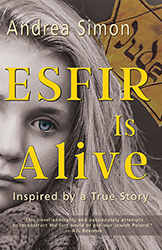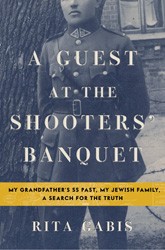Andrea Simon’s novel Esfir Is Alive was published earlier this month. She will be guest blogging for the Jewish Book Council all week as part of the Visiting Scribe series here on The ProsenPeople.
During the research for my memoir, Bashert: A Granddaughter’s Holocaust Quest, my cousin Barbara sent me an envelope affixed with a Post-It, writing, “Hope these help toward closure.” Inside were six postcard-sized, sepia-toned photos, most with names or other identifiers in Yiddish, one stamped with the photographer’s place of business: Visoke, the nearest town to my ancestral village of Volchin in present-day Belarus. My heart sank. These were the photos of the Midler family, my lost relatives killed in the Holocaust. Finally, I could put faces to the people I had been writing about.
As I assembled the photos across my desk, it struck me that these people were well-dressed, stylish even, so like my relatives spread across the United States; I had expected characters out of Fiddler on the Roof in raggedy clothes, lugging overloaded bundles. In my research I not only discovered more about life in the nearby towns and villages, but living people who actually knew the Midlers. These Jews read multiple daily newspapers, joined Zionist and socialist movements, acted in Shakespearean productions, studied Yiddish and Hebrew literature, and argued about the latest psychological and educational theories. They were modern people, not stereotypical facsimiles.
Over the next ten years following the publication of my memoir, I thought about the issues that I was not able to fully cover — particularly the daily life of Jews during the interwar years, a time of great intellectual flux. I wanted to write more about the Midlers. And there was also the story that did not seem to go away: the massacres of 50,000 Jews at the forest site of Brona Gora, culminating in the incredible testimony of the only recorded survivor, a twelve-year-old girl, Esfir Manevich. How could such a young person survive this ordeal?
The more pressing question for me as an author was how I could integrate these topics into a single volume. Would it be another memoir or a work of fiction? How could I include Esfir in the story when I didn’t know if she was still alive to offer corroboration? How could I introduce Esfir to my relatives when they were from different places?
I pondered these challenges over a long time, though I was not aware that various pathways had been germinating in my unconscious. Then it came to me: what if I began a fictional story in 1936, when the real Esfir would have been seven years old? My cousin Ida Midler would have been around fourteen. What if I send Esfir to Brest, the city where Ida attended the Tarbut Hebrew Gymnasium? I thought of my grandmother, who had run a boardinghouse in New York’s Catskill Mountains. Before I knew it, my grandmother morphed into Esfir’s fictional Aunt Perl, proprietor of a boardinghouse in Brest. Because of grave antisemitism at Esfir’s school in her hometown, I would send Esfir to live at Perl’s boardinghouse where she would become roommates with Ida, the counterpart of my real-life cousin. And thus the novel was born.
From the original photos and eyewitness testimony I had collected for my memoir, plus my subsequent research, I reconstructed the village of Volchin. Then I constructed Brest and the area around the boardinghouse. My childhood friends, twin girls, became Ida’s classmates. Now I had the setting and the characters. For a while they were on their own.
 As I changed genres, my focus tightened from revelatory wide angle to exploratory close-up. I switched the point of view from the memoir’s first-person observer to the novel’s first-person actor. I tried to avoid the danger of telling a story by showing Esfir living through trauma, keeping in mind that she was also a witness plodding her way through history. At this point, I decided to pretend that Esfir would be recalling her life as an adult. I was gratified by the reaction of early readers who thought that the novel was nonfiction, an actual memoir written by the real Esfir. So my original memoir found new life in a fictional one.
As I changed genres, my focus tightened from revelatory wide angle to exploratory close-up. I switched the point of view from the memoir’s first-person observer to the novel’s first-person actor. I tried to avoid the danger of telling a story by showing Esfir living through trauma, keeping in mind that she was also a witness plodding her way through history. At this point, I decided to pretend that Esfir would be recalling her life as an adult. I was gratified by the reaction of early readers who thought that the novel was nonfiction, an actual memoir written by the real Esfir. So my original memoir found new life in a fictional one.
Now when I look at the Midler photos, I no longer see a pleasant middle-class family. I see the eldest daughter, Ida, as an idealistic young woman who loved literature; I see my uncle Iser, a handsome man of prominence in his village who also yanked his slacks over his belly. I often wonder what they would think of me, their long-lost relative, poking around in their lives, making up conversations, creating scenarios out of slight resemblances. I like to think they would be proud of me, happy that they were transformed into fully developed lives, to be cherished on the page.
Andrea Simon is the author of the memoir Bashert: A Granddaughter’s Holocaust Quest, the new novel Esfir Is Alive, and several stories and essays. She holds an MFA in Creative Writing from the City College of New York and lives in New York City.
Related Content:
- Nat Bernstein: Photography and Remembrance
- Sande Bortiz Berger: “Is That You on the Cover?”
- Talia Carner: Second-Generation, Forever
Andrea Simon is the author of the memoir BASHERT:, A GRANDDAUGHTER’S HOLOCAUST QUEST, her recent novel ESFIR IS ALIVE, and several published stories and essays. The recipient of numerous literary awards, Andrea holds an MFA in Creative Writing from the City College of New York where she has taught writing. She lives in New York City.




